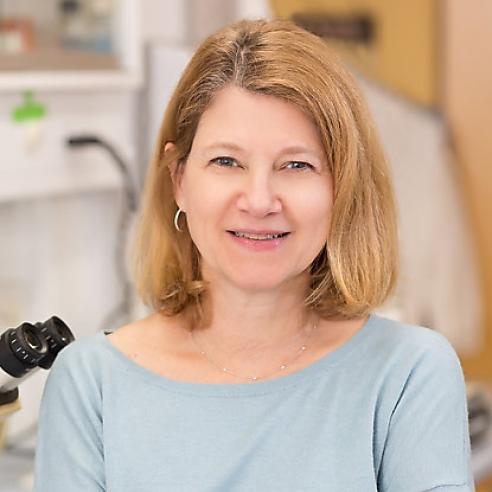Edited Stem Cells Offer Hope for RP Therapy

Skin cells from a patient with X-linked Retinitis Pigmentosa were transformed into induced pluripotent stem cells and the blindness-causing point mutation in the RPGR gene was corrected using CRISPR/Cas9. PHOTO: Vinit Mahajan, University of Iowa Health Care
Using a new technology for repairing disease genes--the much-talked-about CRISPR/Cas9 gene editing, RPB-supported researchers at University of Iowa, working together with Columbia University Medical Center ophthalmologists, have corrected a blindness-causing gene mutation in stem cells derived from a patient. The result offers hope that eye diseases might one day be treated by personalized, precision medicine in which patients' own cells are used to grow replacement tissue.
With the aim of repairing the deteriorating retina in patients with an inherited blinding disease, X-linked Retinitis Pigmentosa (XLRP), Alexander Bassuk, MD, PhD, and Vinit Mahajan, MD, PhD, led a team of researchers who generated stem cells from patient skin cells and then repaired the damaged gene. The editing technique is so precise it corrected a single DNA change that had damaged the RPGR gene. More importantly, the corrected tissue had been derived from the patient's own stem cells, and so could potentially be transplanted without the need for harmful drugs to prevent tissue rejection. The research was published Jan. 27 in the journal Scientific Reports.
"With CRISPR gene editing of human stem cells, we can theoretically transplant healthy new cells that come from the patient after having fixed their specific gene mutation, " says Mahajan, clinical assistant professor of ophthalmology and visual sciences in the UI Carver College of Medicine. "And retinal diseases are a perfect model for stem cell therapy, because we have the advanced surgical techniques to implant cells exactly where they are needed."
The study was a "proof-of-concept" experiment showing it is possible not only to repair a rare gene mutation, but that it can be done in patient stem cells. Use of stem cells is key because they can be re-programmed into retinal cells.
The CRISPR technology was able to correct the RPGR mutation in 13 percent of the stem cells, which is a practically workable correction rate.
Bassuk notes this result is particularly encouraging because the gene mutation sits in a highly repetitive sequence of the RPGR gene where it can be tricky to discriminate one region from another. In fact, initially determining the DNA sequence in this part of the gene was challenging. It was not clear that CRISPR/Cas9 would be able to home in on and correct the "point mutation."
"We didn't know before we started if we were going to be able to fix the mutation," says Bassuk, associate professor in the Stead Family Department of Pediatrics at University of Iowa Children's Hospital.
Developed just three years ago, CRISPR/Cas9 has been heralded as a major breakthrough in genetic engineering, allowing scientists to easily, precisely, and relatively cheaply make specific alterations to the DNA in cells and experimental animals.
The technology has not yet been used in humans, so safety concerns remain about the potential for unanticipated genetic changes. Also, ethical concerns arise given this technique's capability to make permanent genetic changes in sperm and egg cells. Nevertheless, the possibility of being able to fix diseased genes has tremendous potential.
"There is still work to do," says Stephen Tsang MD, PhD, a collaborator and associate professor of ophthalmology at Columbia University Medical Center. "Before we go into patients, we want to make sure we are only changing that particular single mutation and we are not making other alterations to the genome."
Bassuk adds, "I think there is hope in real time for patients with this particular retinal degenerative disease."
###
In addition to Bassuk, Mahajan, and Tsang, the research team included Andrew Zheng and Yao Li at Columbia University Medical Center.
The study was funded in part by grants from the National Institutes of Health, the Doris Duke Charitable Foundation, and Research to Prevent Blindness.
January 27, 2016
Related News: Feature Story, Gene Therapy, Retinitis Pigmentosa, Stem Cell Therapy, Top Story

Vision Research Funding Partnership Event Takes Place Today
Leaders of organizations that fund vision research convene in Washington, D.C. to increase collaboration and maximize the impact of research funding for sight-threatening diseases.

Research to Prevent Blindness and Alcon Award Glaucoma Grant
Dr. Alex Huang of the University of California San Diego School of Medicine will study glaucoma filtration surgeries with the aim of improving surgical success for lowering eye pressure and providing neuroprotection.

Researchers Build An “Aging Clock” To Help Treat Eye Disease
The new way to measure ocular aging opens treatment avenues for numerous eye diseases.

Research to Prevent Blindness and the American Academy of Ophthalmology Award Big Data Research Grants for Improved Patient Care
The American Academy of Ophthalmology (AAO) and Research to Prevent Blindness (RPB) today announced the 2023 recipients of the RPB/AAO Award for IRIS Registry Research.

In Memoriam: Herbert J. Siegel
RPB acknowledges the passing of a dedicated former Board member.

Research to Prevent Blindness and Association of University Professors of Ophthalmology Announce 2024 Recipient of RPB David F. Weeks Award for Outstanding Vision Research
Patricia Ann D’Amore, PhD, MBA, is recognized for ground-breaking contributions to the field of vision research.
Subscribe
Get our email updates filled with the latest news from our researchers about preventing vision loss, treating eye disease and even restoring sight. Unsubscribe at any time. Under our privacy policy, we'll never share your contact information with a third party.
| General Info | Grants | News & Resources |



